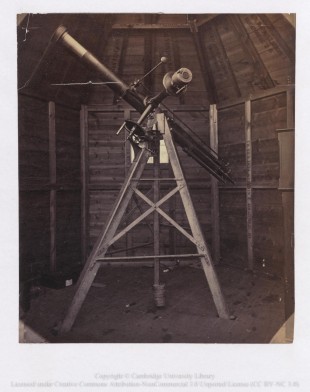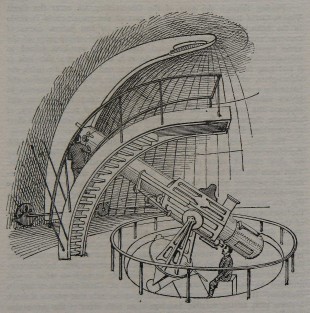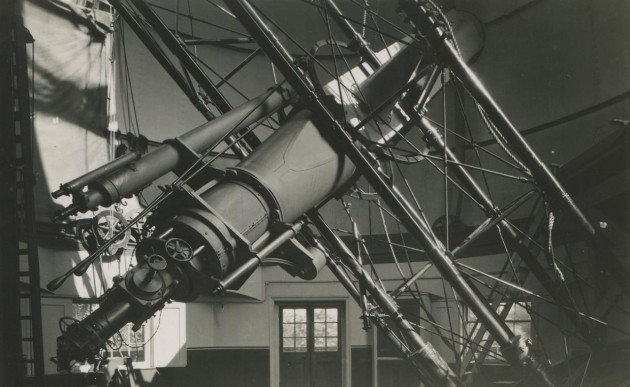…where east meets west
- Home
- Brief History
- The Greenwich Meridian
- Greenwich
(1675–1958) - Herstmonceux
(1948–1990) - Cambridge
(1990–1998) - Outstations (1822–1971)…
- – Chingford (1822–1924)
- – Deal
(1864–1927) - – Abinger
(1923–1957) - – Bristol & Bradford on Avon
(1939–1948) - – Bath
(1939–1949) - – Hartland
(1955–1967) - – Cape of Good Hope
(1959–1971)
- Administration…
- – Funding
- – Governance
- – Inventories
- – Pay
- – Regulations
- – Royal Warrants
- Contemporary Accounts
- People
- Publications
- Science
- Technology
- Telescopes
- Chronometers
- Clocks & Time
- Board of Longitude
- Libraries & Archives
- Visit
- Search
Telescope: Corbett Equatorial

Taken in either 1873 or 1874, this photograph shows the Corbett Equatorial undergoing testing at Greenwich prior to being sent to Kerguelen Island for the Transit of Venus. The hut in which it is standing has had the front panels temporarily removed so that the telescope could be seen inside. reproduced under the terms of a Creative Commons Attribution-Non-Commercial (CC BY-NC) licence courtesy of Cambridge Digital Library (see below)
The Transit of Venus expeditions

The Lassell Telescope in its dome at Greenwich with the lower of the two observers looking though the eyepiece of the Corbett refractor. Sketched from life by an artist from the Pall Mall Gazette on 27 January 1888 (RGO7/29), it was originally published by the Pall Mall Gazette on 30 January 1888, and later reproduced by Cudworth on p.321 of his book: Life and Correspondence of Abraham Sharp (London, 1889)
Together with many of the other Transit of Venus instruments, including all five of the other 6-inch equatorials, the Corbett was formally transferred to the Royal Observatory in 1876. In 1881, in preparation for the 1882 Transit, the Corbett was adapted for use on the superior equatorial mounting on one of the Dalmeyer Photoheliographs and erected for trial in the South Ground. The telescope was subsequently shipped to Madagascar for the Transit which took place on 6 December and where the observer is thought to have been Sidgreaves. It was returned to Greenwich on 31 January 1883 (RGO6/283/450 & 461).
Later use as a sighting telescope
In January 1887, the Corbett refractor was attached in the fairly recently acquired Lassell Equatorial for use both as a guiding telescope and for the observation of occasional phenomena. It remained there until November 1891 when its place was taken by the newly acquired Thompson Photoheliograph. It was transferred to its current location as the guiding telescope of the newly completed 28-inch Refractor in 1893. Originally mounted above the main telescope tube, it is thought to have been moved to its present position below it in 1920.
Loan of the mounting
The mounting (or parts of it) are known to have been lent for at least three different eclipse expeditions:
- Parts of the mounting lent for eclipse expedition to island of Granada for the August 1898 solar eclipse.
- Mounting lent to Rev. Perry for the December 1889 solar eclipse
- Declination and polar axis, circles and clock lent to Joint Eclipse Expedition for Solar Eclipse of April 1893.
In the 1893 inventory (RGO7/67), the stand is listed as being in two cases in the workshop in the basement of the New Physical Building (South Building). No mention of either the stand or mounting has been found in the three inventories compiled between 1911 and 1933 (RGO39/4, 39/5 & 39/6), suggesting that they were probably disposed of at some point before Christie retired as Astronomer Royal in 1910.
Contemporary accounts
Account of observations of the Transit of Venus, 1874, December 8, made under the authority of the British government: and of the reduction of the observations. Edited by Sir George Biddell Airy, (HMSO, 1881)

Dating from around 1915–,20, this photo shows the Corbett mounted in its original position on the 28-inch Refractor. From a postcard published by the Royal Observatory, Greenwich
Image Licensing
The image of the Corbett Equatorial in the Transit of Venus hut at Greenwich is reproduced in compressed and slightly cropped form under the terms of a Creative Commons Attribution-NonCommercial 3.0 Unported License courtesy of Cambridge Digital Library (RGO6/276).
© 2014 – 2025 Graham Dolan
Except where indicated, all text and images are the copyright of Graham Dolan